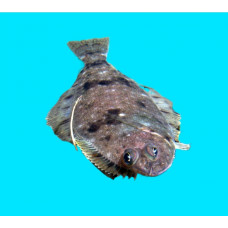Latin name
Microstomus pacificus
Other name
Slime sole or slippery sole.
Identification
The body of the Pacific Dover sole is soft, flaccid with small scales and very slippery due to the large amount of mucus covering it. They have a nearly straight lateral line with a short, unconnected branch at the top of the head; there is no additional dorsal branch. Fish have 50-54 vertebrae. The dorsal section begins above the center of the upper eye. The caudal section is not quite rounded. The mouth is very small, with flat, incisor-like teeth located mostly on the blind side. They have large, convex eyes with a convex space between them; the upper eye is posterior to the lower eye. This species lacks an anal process.
Features of fish fins
Dorsal spines (total): 0; Dorsal soft rays (total): 90 - 116; Anal spines: 0; Anal soft rays: 80 - 96.
Fish colouring
The eye side is brown or grayish brown and may be mottled with darker patches. The blind side is off-white to dark brownish gray. The dorsal and anal fins are blackish along the edges.
Distribution
Widespread in the eastern Pacific: from Navarin Canyon in the Bering Sea to Dead End Bank in the Aleutian Islands and San Cristobal Bay, Baja California, Mexico. This species has been found near the methane seep off the coast of Del Mar, Southern California.
Habitat
A marine bottom dweller that prefers temperate climates. The depth range of these fish is from 10 to 1370 meters.
Size
The maximum length of this species is 76.0 cm for the male, with a total length of 40.0 cm. Maximum reported weight is 3.5 kg. Maximum reported age is 56 years.
Behavior
Adults live on muddy bottoms. In winter they move to deeper water.
Food and feeding habits
These fish often burrow into the sand and wait for prey. Feeding mainly at night on crustaceans, shrimps, worms and molluscs, small bivalves, starfish and snails, and rook molluscs. Sipunculids, polychaetes, nematodes, echinoderms, and gastropods, as well as the eggs of bottom-dwelling mollusks, are also included in the diet of juvenile fish.
Reproduction
They become sexually mature at 7 years of age. Males mature earlier than females. The spawning season lasts from November to May, with intensive spawning in December, January and February. A few individuals spawn in November and March. Fecundity is approximately 52,000-256,000 eggs, depending on the size of the fish. Eggs are swimming, pelagic and free-swimming. The larval stage lasts up to 1 year. Juveniles become bottom dwellers, with a standard length of 50 to 55 mm, when they settle on the bottom and can be found on shore. Larvae lead a prolonged pelagic life for several months and metamorphosis is delayed.
Fishing
Commercially important species. Mostly caught with bottom trawls. Dover sole release large amounts of mucus that can cover other fish caught with them.
Relationship with a person
Harmless. The fish is soft to the taste, with dense flesh. It is sold as mince or fillets.
| Classification | |
| Phylum | Chordata |
| Class | Actinopterygii |
| Squad | Carangiformes |
| Family | Pleuronectidae |
| Genus | Microstomus |
| Species | M. pacificus |
| Features | |
| Conservation status | Least Concern |
| Habitat | Bottom |
| Life span, years | 56 |
| Maximum body weight, kg | 3,5 |
| Maximum length, cm | 76 |
| Sailing speed, m/s | No information |
| Threat to people | Edible |
| Way of eating | Predator |
Pacific Dover sole
Tags: pacific dover sole

